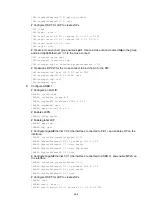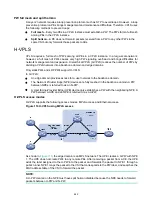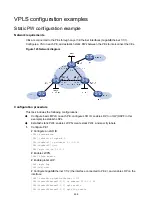
445
•
Configure VPLS on PEs. For example, configure a VSI, establish a PW, and associate an AC
and a VSI.
This chapter describes only VPLS configurations on a PE. For information about other configurations,
see relevant configuration guides.
To configure VPLS on a PE, perform the following tasks:
Tasks at a glance
Remarks
(Required.)
N/A
(Required.)
N/A
(Required.)
N/A
:
•
(Optional.)
•
(Required.) Choose either of the following tasks to configure a PW:
{
{
{
{
Configuring a BGP auto-discovery LDP PW
Choose a PW configuration
method depending on the
VPLS implementation.
(Required.)
In an H-VPLS using MPLS
access, do not perform this
task on the access NPEs of the
UPEs.
(Optional.)
•
Configuring static PW redundancy
•
N/A
(Required.)
Configuring MAC address learning
N/A
(Optional.)
Enabling SNMP notifications for L2VPN PW
Enabling L2VPN
Before you enable L2VPN, perform the following tasks:
•
Configure an LSR ID for the PE with the
mpls lsr-id
command.
•
Enable MPLS with the
mpls enable
command on the backbone interface of the PE.
To enable L2VPN:
Step Command
Remarks
1.
Enter system view.
system-view
N/A
2.
Enable L2VPN.
l2vpn enable
By default, L2VPN is disabled.
Configuring an AC
An AC can be one of the following types on a PE:
•
Layer 3 Ethernet interface
—Transparently forwards received packets to the bound VSI.
•
Layer 3 Ethernet subinterface
—Forwards received packets to the bound VSI. In this mode,
VLANs are unique on a per-interface basis rather than on a per-device basis.
















































